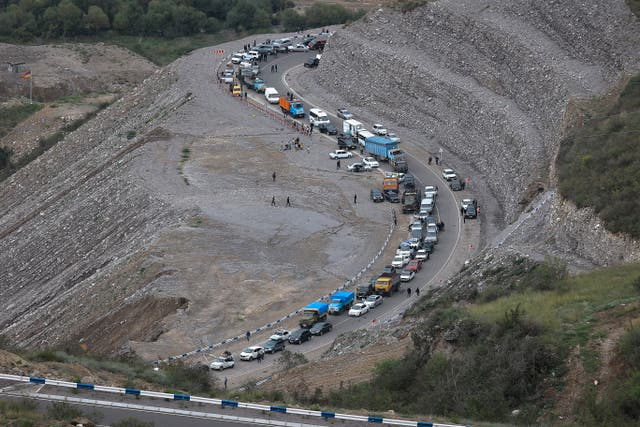Ex-head of Nagorno-Karabakh’s separatist government detained by Azerbaijan
Ruben Vardanyan was held as he tried to cross into Armenia.

Azerbaijan’s border guard has detained the former head of Nagorno-Karabakh’s separatist government as he tried to cross into Armenia.
The arrest of Ruben Vardanyan appears to reflect Azerbaijan’s intention to quickly enforce its grip on the region after a swift military operation last week.
Mr Vardanyan, a billionaire businessman who made his fortune in Russia where he owned a major investment bank, moved to Nagorno-Karabakh in 2022 and served as the head the regional government for several months before stepping down earlier this year.
Azerbaijan’s border guard service said Mr Vardanyan was escorted to the country’s capital, Baku, and handed over to “the relevant state bodies” that will decide his fate. It posted a picture of Mr Vardanyan held by two border guards next to a helicopter.
The arrest came after Azerbaijan’s Health Ministry revealed a total of 192 soldiers were killed and more than 500 were wounded during the country’s offensive in Nagorno-Karabakh last week.

The military operation allowed Azerbaijan to reclaim full control over the breakaway region that was run by separatists for about 30 years.
Tens of thousands of ethnic Armenians have already left the region and more are likely to do so after separatist troops agreed to lay down arms and Azerbaijan lifted a 10-month blockage of the road linking the territory to Armenia.
Azerbaijan and separatist officials have held two rounds of talks on the “reintegration” of Nagorno-Karabakh and its ethnic Armenian population into the mainly Muslim country but how exactly it would happen remains unclear.
Nagorno-Karabakh is a region of Azerbaijan that came under the control of ethnic Armenian forces, backed by the Armenian military, in separatist fighting that ended in 1994.
During a six-week war in 2020, Azerbaijan took back parts of Nagorno-Karabakh along with surrounding territory that Armenian forces had claimed during the earlier conflict.

Armenia said that the closure denied basic food and fuel supplies to Nagorno-Karabakh’s approximately 120,000 people.
Azerbaijan rejected the accusation, arguing the region could receive supplies through the Azerbaijani city of Aghdam — a solution long resisted by Nagorno-Karabakh authorities who called it a strategy for Azerbaijan to gain control of the region.
More than 47,000 people, or nearly 40% of Nagorno-Karabakh’s population of 120,000, have left the region for Armenia as of early afternoon on Wednesday, according to the Armenian authorities.
An explosion at a petrol station near the region’s capital Stepanakert, where people were queuing to fill up their cars before leaving for Armenia, on Monday night killed at least 68 people, according to Nagorno-Karabakh’s human rights ombudsman Gegham Stepanyan.
Another 290 were wounded and a total of 105 were considered missing as of Tuesday evening, he said.
Those wounded in the blast were taken by ambulance and helicopter to hospitals in Armenia.
Tatev Mirzoyan, a 27-year-old resident of Stepanakert who arrived in the Armenian city of Goris with her family after a 28-hour drive, said they used fuel they had stashed for emergency purposes.
“We were seven in one little car,” she said. “That was a horrible journey as people are in panic and nervous.”
Ms Mirzoyan said she and her family are planning to stay with her sister who lives in Armenia’s capital Yerevan, adding that she does not want to think about the future for now.
Some of her relatives are still searching for fuel to leave Nagorno-Karabakh, she added. “My cousin is still under siege in Martuni, she is waiting to be taken out to Stepanakert, and after that figure out what to do next.”





